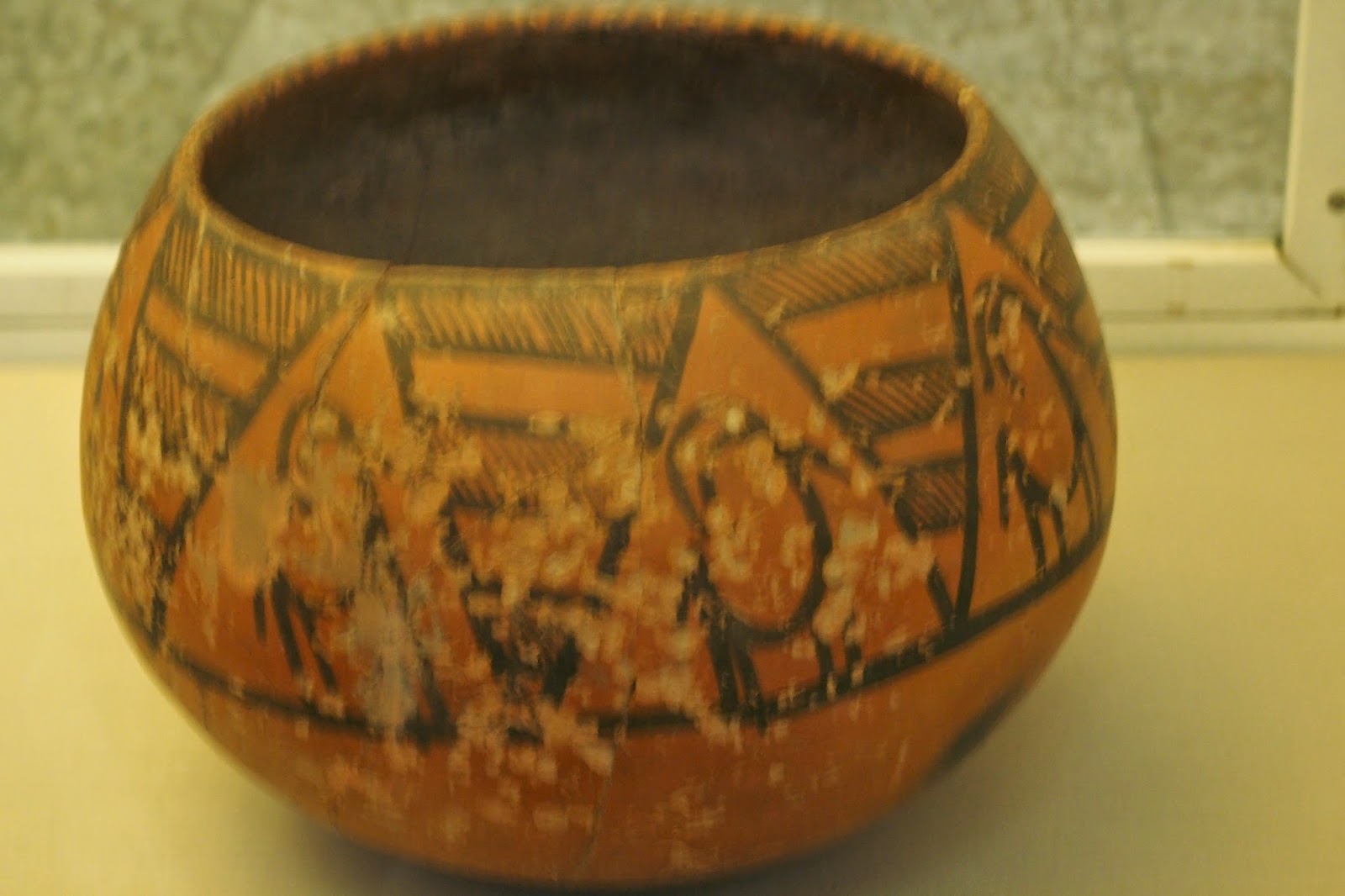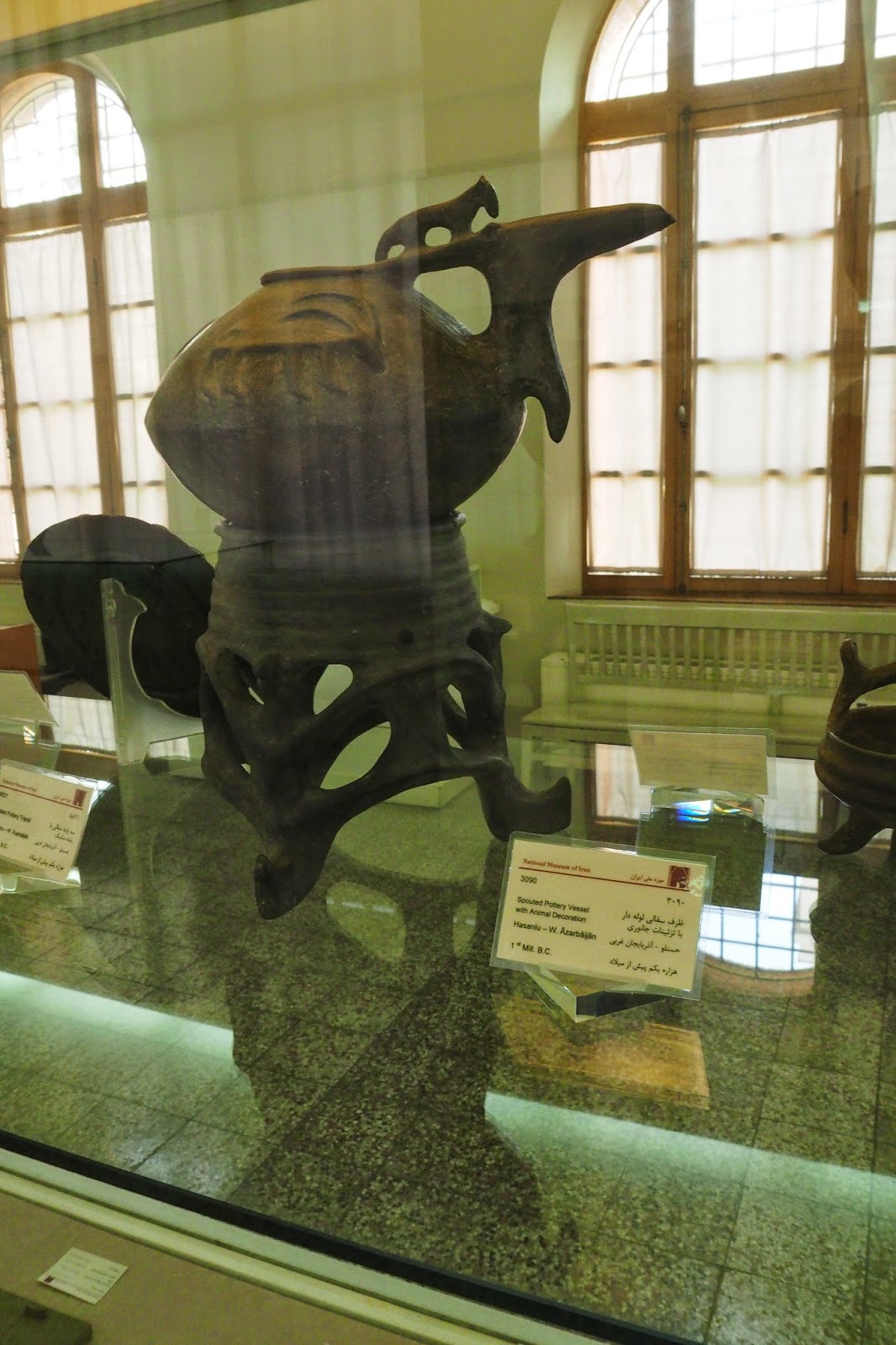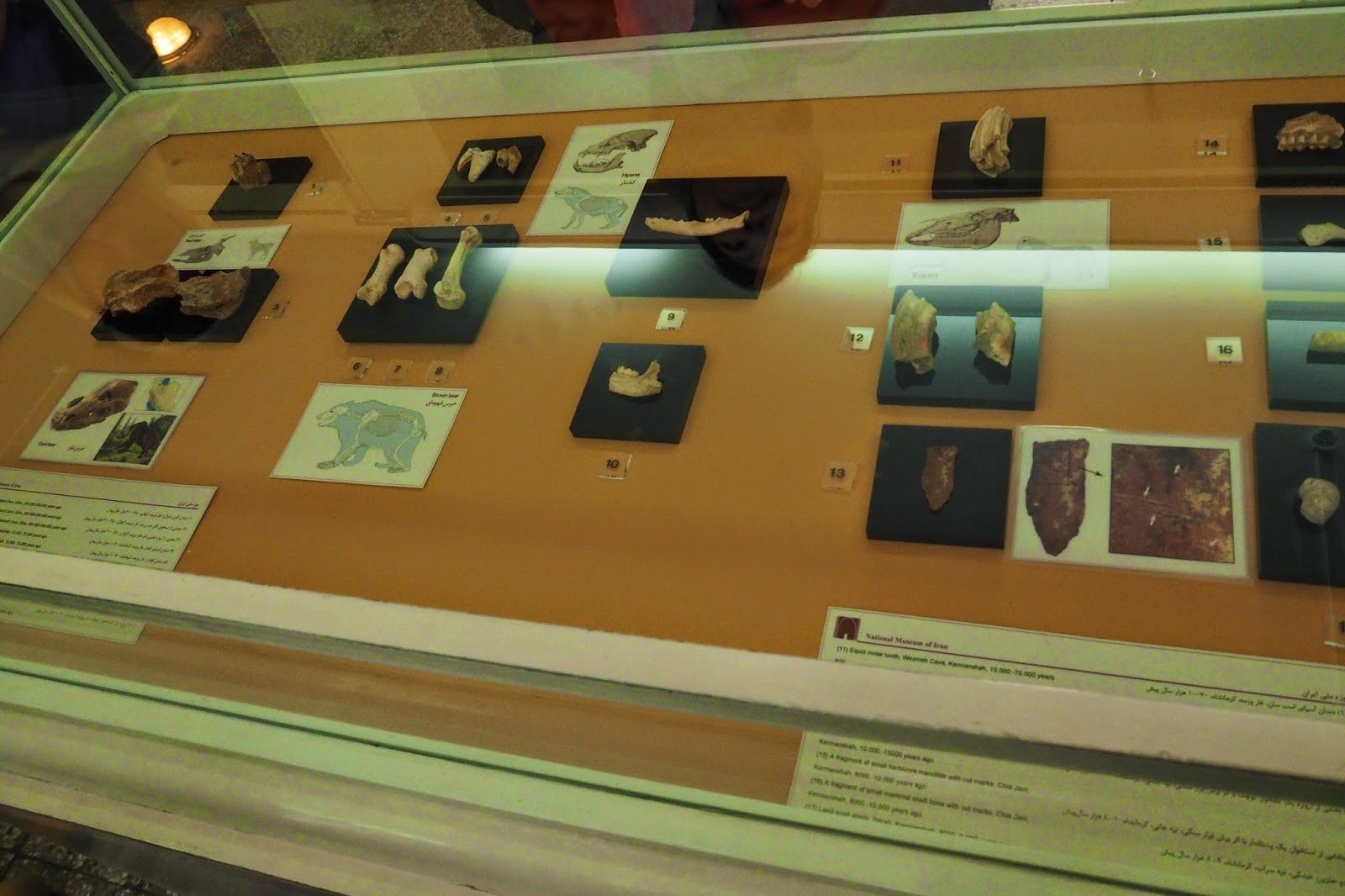The second building housing the Museum of the Islamic Era also has three floors and exhibits various pieces of pottery, textiles, texts, artworks, astrolabes, and adobe calligraphy from Iran's post-Islamic era .
We were told that the Museum of Archaeological Iran was designed by the French architect Andre Godard using the kind of brick laying style peculiar to Persian architecture.
and its main entrance adopts the style of Sassanid vaults, particularly the iwan of Ctesiphon, the imperial capital of the Parthian or Arsacid (247 BC – 224 CE) Empire and Sassanid Empire(224-651 CE ), the largest city in the world from 570 CE, until its fall in 637 CE during the Muslim conquests.
A full frontal view of the main entrance with its beautiful curves and arches punctuated by straight lines in the typical brownish yellow color of Persian bricks broken by some Persian calligraphic script written in gold over a band of green mosaic tiles.
Another view of the entrance of the museum

Before entering the museum, we met this group of happy young Iranian school boys.

Other school children soon joined in the fun. Even one of our older tour group members did not want to miss the fun!
The name of the museum in Persian with the year also written in Persian numerals.
Another replica of the famous Cyrus Cylinder found in March 1979 by the Assyro-British archaeologist Hormuzd Rassam for the British Museum in Omran [Tell Amran-ibn-Ali] together with about six hundred other pieces of inscribed terracottas in Mesopotamia (present day Iraq). It has been described as "the first charter of human rights" in world history by Shah Mohammad Reza Pahlavi in 1971 but Neil McGregor, director of the British Museum, merely says that it's "the first attempt we know about running a society, a state with different nationalities and faiths—a new kind of statecraft."
The head of the "Salt man" found in 1993 at a foothill facing the Chehrabad River south of the Hamzelloo Village who died some 1,700 years ago.
The explanatory note to the exhibit
His boot?
A terra cotta model of a house found at Sang-e-Chakmaq Tepe-Semman 5th millenium BCE
A large painted pottery vessel found at Esmael Abad-Alborz 5th millenium BCE
A large painted pottery vessel found at Esmael Abad-Tehran 5th millenium BCE
A large painted pottery vessel found at Qomrood, Qom 5th millenium BCE
A map showing where the various artifacts were found
The index of the various locations on the map
Various fragments of animal teeth , bones etc dated 8,000 to 200,000 years ago


Legend of the various exhibits

Molar teeth of hyena found at the Wezmeh Cave, Kermanshah 10,000-70,000 years ago
The legend of the exhibits
A T-shape clay figurine found at Danj Darreh Tepe in Kermanshah 8th millenium BCE
A T-shape clay figurine found at Danj Darreh Tepe in Kermanshah 8th millenium BCE
Fragment of a pottery vessel found at Tall-e Jari, Fars Mid-7th millenium BCE
A fragment of pottery vessel found at Qaleh Rostam in Chahar Mahal Bakhtiyari mid 7th millenium BCE

A female figurine found in Sarab in Kermanshah, 7th millenium BCE
A fragment of pottery vessel found at Qaleh Rostam in Chahar Mahal Bakhtiyari mid 7th millenium BCE

A female figurine found in Sarab in Kermanshah, 7th millenium BCE
T-shaped clay figurine and stone human figure all found in Talle-e-Tulaii , Khezestan mid-7th millenium BCE

A pottery figurine of a wild boar found in Sarab in Kermanshah, 7th millenium BCE
A dog figurine found in Ali Kosh in Dehloran Llam 7th millenium BCE

A tall perforated heating bowl found in Jari in Fars 6th millenium BCE

A pottery figurine of a wild boar found in Sarab in Kermanshah, 7th millenium BCE
A dog figurine found in Ali Kosh in Dehloran Llam 7th millenium BCE

A tall perforated heating bowl found in Jari in Fars 6th millenium BCE
A clay animal figurine found at Bakun A in Fars, late 5th millenium BCE

A human shaped bone handle on the left found in Sialk in Kashan (Isfahan) th millenium BCE and a human figurine found in Susa Khuzestan also 5th millenium BCE




Various pottery bowls with zig-zag patterns and antelope figures found at Esmael Abad in Alborz, 5th millenium BCE

Pottery bowls with antelope figures found at Esmael Abad in Alborz, 5th millenium BCE

A footed pottery bowl with 3 different types of geometric patterns found at Esmael Abad in Alborz, 5th millenium BCE. They look remarkably like those pottery found in China in the corresponding period.
Pottery Bowl with antelope figures found at Shahriyar in Tehran 5th millenium BCE
Pottery Bowl found at Cheshmeh Ali in Tehran 5th millenium BCE

A big pottery vessel with plant patterns found in Bakun in Fars 5th millenium BCE


A cylindrical pottery vessel with mixed checkers and triangular patterns found in Bakun in Fars 5th millenium BCE
A yellow bowl with three different types of dots, lines, band embodying dual-color squares l found in Susa in Khuzestan 5th millenium BCE
Another pottery bowl with 4 different geometric patterns found at Susa in Khuzestan late 5th millenium BCE

A tall pottery beaker with 4 different types of geometric patterns found in Susa in Khuzestan 5th millenium BCE

A pottery bowl with human figure alone and holding hands (?) found in Susa in Khuzestan 5th millenium BCE

Another pottery bowl with mainly squares, checkers and rectilinear patterns found at Susa in Khuzestan late 5th millenium BCE
A pottery vessel with all curve-line patterns found at Bakun in Fars 5th millenium BCE
A footed pottery bowl with both geometrical and animal figures found in Hesar in Semnan, 4th millenium BCE

A carinated pottery bowl found in Sialk (Kashan) in Isfahan 4th millenium BCE

A Venus figure with lug handle found in Susa in Khuzestan early 3rd millenium BCE
A pottery bowl in the shape of a human figure found in Shahr-e Soukhteh in Sistan va Balouchestan, 3rd millenium BCE

Decorated Glazed Vase in the neo-Elamite period (1100-539 BCE) found at Susa Khuzestan
Handled Pottery Vessel found in Shahr-e Soukhteh in Sistan va Baloucjestan 3rd millenium BCE
A footed pottery bowl with smooth flowing lines found in Shahr-e Soukhteh in Sistan va Balouchestan 3rd millenium BCE
An urn with a big lid found with leaf-design found in Shahdad of Kerman, 3rd millenium BCE

A pottery flask with fern leaf design found in Shahdad in Kerman 3rd millenium BCE

Pottery Bowl found at Shahr-e Soukhteh in Sistan va Balouchestan 3rd millenium BCE

A clay pot with spout and geometric lines found in Susa in Khuzestan 3rd millenium BCE

A huge painted pottery vessel with both complex geometric patterns and animal figures found at Giyan in Hamadan 3rd millenium BCE

a terra cotta lion statue with glazed eyes statue found at Susa in Khuzestan 2nd millenium
A tripod pottery vessel with simple geometric designs found at Giyan in Hamedan, late 2nd millenium BCE
A button base pottery with ear with a mixture of geometric and plant design found in Giyan Hamedan, 2nd millenium BCE

Another tall button base vessel with geometric and bird design found in Giyan Hamedan, 2nd millenium BCE
A pottery bull head found in Giyan Hamedan 2nd millenium BCE
A small pottery vessel within a vessel found in Hesar in Semnan 2nd millenium BCE
A smooth glazed pottery pitcher found in Turang Tapeh in Golestan 2nd millenium BCE
A joined triple pottery pitcher with a spout found in Shah Tapeh in Golestan early 2nd millenium BCE
A human upper body bust shaped glazed bottle found in Shah Tapeh in Golestan, 2nd millenium BCE

Terra cotta moulded figurine found at Chogha Zanbil-Khuzestan late 2nd millenium BCE
A carved bitumen vessel found in Susa in Khuzestan late 2nd millenium BCE
A beautifully carved bitumen bowl with ram handle found in Susa Khuzestan late 2nd millenium BCE
A double ram handled ram carved bitumen vessel found in Susa in Khuzestan in late 2nd millenium BCE

A pottery flask with alternative dark glazed rings of varying thickness upon the unglazed original surface of the baked clay found in Susa in Khuzestan 2nd millenium BCE
A photograph plus the accompanying explanation of the historical importance of Susa
The Miro-like lines on the exterior of a clay pot with a lug handle found at Susa in Khuzestan 1st millenium BCE
A realistic looking bull at ziggurat (terraced pyramidal religious structures) at Chogha Zanbil of the Elamite Empire
The transcription of the dedication of the bull to the god Inshushinak, the protector god of the city of Susa. The Elamites was an ancient pre-Iranic civilization in the far west and southwest of present day Iran centered on present day Khuzestan and Llam provinces, often referred to in ancient texts as Susiana, after the name of its capital city Susa but Susiana is not synonymous with Elam which in its early history is a separate cultural and political entity.In the old Elamite period which corresponded to the Middle Bronze Age, Elamites ruled the Iranian plateau centered in Anshan and from the 1500's BCE on it was centered on Susa in the Khuzestan lowlands and its culture played a crucial role in the later Persian Achaemenid dynasty that succeeded the Elamite Dynasty which lasted roughly from 3,200 to 539 BCE. Anshanite dynasties (predecessor of the Elamite Empire) began around 1500 BCE when they "Elamized" Susa as their kings took the title "king of Anshan and
Susa". While the first of these dynasties, the Kidinuids (c1500–1400 BCE ) , a group of five rulers of
uncertain affiliation, continued to
use the Akkadian language frequently in their inscriptions, the
succeeding Igihalkids and Shutrukids used Elamite with increasing
regularity. Likewise, Elamite language and culture grew in importance in
Susa : they are identified by their use of the older
title, "king of Susa and of Anshan", and by calling themselves "servant
of Kirwashir", an Elamite deity, thereby introducing the pantheon of the
highlands to Susiana. The Elamites practised polytheism but at one point their pantheon of gods was headed by the goddess Kiririsha/Pinikir.but they also worshipped Inshushinak and Jabru, lord of the underworld. In the transcription, Untash-Gal the Elamite king referred to himself as "king of Anshan and Susa".

This is the Elamite ziggurat at Chogha Zanbil, 30 km southeast of Susa where the inscription was taken. "Chogha" in Bakhtiari means "hill". "Choga Zanbil" means 'basket mound.' It was built about 1250 BC by the king Untash-Napirisha, mainly to honor the great god Inshushinak. Its original name was Dur Untash, which means 'town of Untash', but it is unlikely that many people, besides priests and servants, ever lived there. The complex is protected by three concentric walls which define the main areas of the 'town'. The inner area is wholly taken up with a great ziggurat dedicated to the main god, which was built over an earlier square temple with storage rooms also built by Untash-Napirisha.The middle area holds eleven temples for lesser gods. It is believed that twenty-two temples were originally planned, but the king died before they could be finished, and his successors discontinued the building work. In the outer area are royal palaces, a funerary palace containing five subterranean royal tombs.Although construction in the city abruptly ended after Untash-Napirisha's death, the site was not abandoned, but continued to be occupied until it was destroyed by the Assyrian king Ashurbanipal in 640 BCE. Some scholars speculate, based on the large number of temples and sanctuaries at Chogha Zanbil, that Untash-Napirisha attempted to create a new religious center (possibly intended to replace Susa) which would unite the gods of both highland and lowland Elam at one site.

A complex pottery vessel with tripod legs in the form of creeper branches and decorative animal figure found at Hasanlu in West Azabaijan 1st millenium BCE

A clay urn with beautifully flowing lines with heads of animal and snake combined with geometric patterns found at Sialk at Kashan Esfahan 1st millenium BCE

(To be cont'd)
A pottery fish with geometrical patterns at Luristan 1st millenium BCE
A 4-footed clay vessel with two animal shaped lugs at Luristan 1st millenium BCE
A spouted clay vessel from Surkh Dum in Luristan 900-800 BCE
Another spouted clay vessel with a top handle at Luristan 1st millenium BCE
A pottery musical instrument found at Luristan 1st millenium BCE
A proto-type clay vessel with a strainer found at Hasanlu in West Azarbaijan 1st millenium
BCE
BCE

A complex pottery vessel with tripod legs in the form of creeper branches and decorative animal figure found at Hasanlu in West Azabaijan 1st millenium BCE

A animal-shaped Pottery found in Amarlu in Gilan Province 1st millenium BCE
An elaborately painted clay vessel found at Sialk in Esfahan (Kashan) 1st millenium BCE
A clay urn with beautifully flowing lines with heads of animal and snake combined with geometric patterns found at Sialk at Kashan Esfahan 1st millenium BCE
More painted painted spouted clay pots found at Sialk in Kashan Esfafan 1st millenium BCE
6 clay pots with a spout joined at the base with common channel and 3 feet found at Kaluraz in Gilan 1st millenium BCE
A triplex pottery vessel with a spout and a handle found at Kaluraz in Gilan 1st millenium BCE
A clay rython found at Amrlu in Gilan 1st millenium BCE

A clay deer figure found at Marik in Gilan 1st millenium
A clay rython found at Marik in Gilan 1st mllenium BCE
Another smooth looking animal found at Marik in Gilan 1st mllenium BCE
Animal shaped pottery found at Amarlu in Gilan 1st millenium BCE
A compound clay pot found at Nesfi in Gilan 1st millenium BCE
Animal shaped vessel found at Zwiyeh in Kordestan 1st millenium BCE
Two clay pots joined by an animal in the middle found at Noor in Mazandaran 1st millenium BCE
Terra cotta statue of Bacchus the Roman god of wine and fertility found in Susa of Khuzestan of the Parthian Dynasty (247 BCE to 224 CE), roughly equivalent to the period of Han Dynasty in China (206 BCE -220 CE)
(To be cont'd)







































































沒有留言:
張貼留言